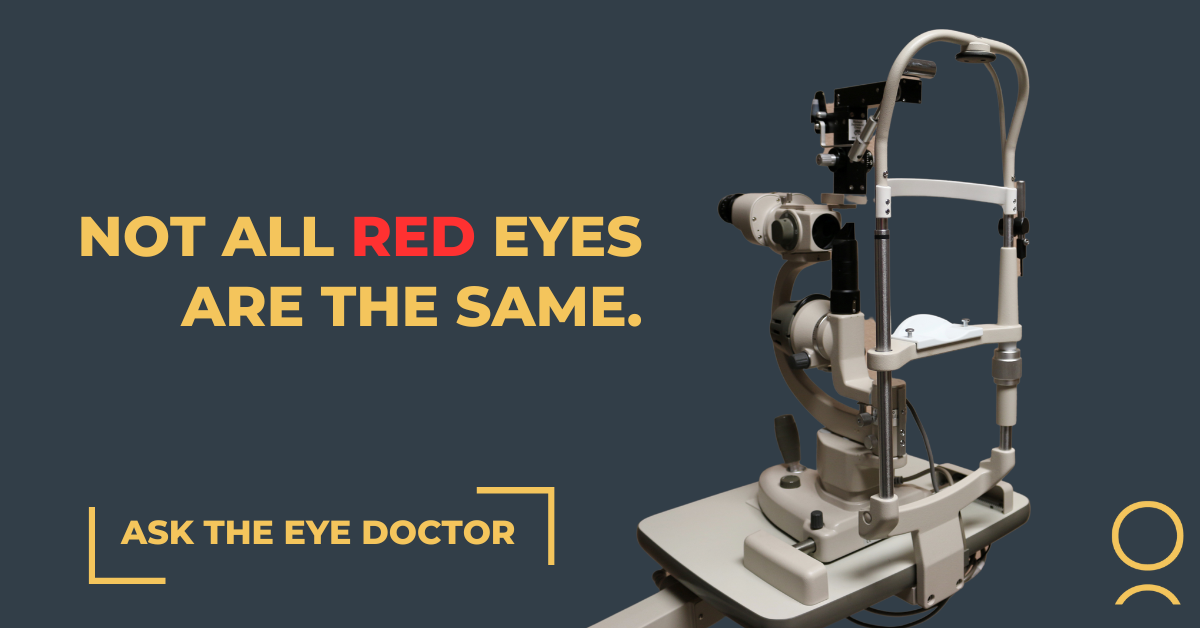Not All Red Eyes Are The Same
Red eyes are a common concern for many of our patients. They always seem to occur at the most inconvenient time and often cause a great deal of discomfort, pain or even changes to our vision. It's important to remember that not all red eyes are the same. While some eye health concerns may resolve on their own with minimal treatment, others could indicate an underlying eye condition that requires immediate attention.
As an optometrist, I believe it's crucial for patients to understand the significance of seeking professional care when experiencing red eyes. This is because a red eye could potentially pose as a serious vision threatening problem that may require a specific treatment or in some cases a referral to an eye specialist.
Medical eye care visits to your optometrist are completely covered by Alberta Health Care. This includes red eyes, goopy eyes, lumps, bumps and visual changes. All you need to do is book your eye appointment and bring your Alberta Health Care card. We leave space in your schedule to take these eye urgencies and emergencies to get you back feeling your best as fast as possbile.
In this blog post, we'll discuss various conditions that can cause a red eye, such as conjunctivitis, uveitis, and dry eye disease, their symptoms, and why a medical eye exam with your optometrist is essential for accurate diagnosis and treatment.
Conjunctivitis - Red Eye
Commonly known as pink eye, conjunctivitis is an inflammation of the conjunctiva, the thin clear tissue that covers the white part of the eye and the inner surface of the eyelids. Conjunctivitis can be caused by viral or bacterial infections, allergies, or irritants. Determining the cause is essential to prescribing the correct treatment. Symptoms of conjunctivitis include:
Redness and irritation in one or both eyes
Excessive tearing or discharge, which can be watery or thick and yellow/green in bacterial cases
Itchy or gritty sensation
Crusting of eyelashes, especially after sleeping
Treatment:
Depending on the underlying cause your optometrist may treat conjunctivitis with prescription eye drops or in some cases oral medications. In almost all cases, over the counter eye drops like Polysporin are unhelpful, and eye drops such as Visine are completely useless.
Uveitis - Red Eye
Uveitis refers to the inflammation of the uvea, the middle layer of the eye. This condition is also known as Iritis or the inflammation of the iris (colored part of the eye). It can occur as a result of an infection, an autoimmune condition, or an underlying systemic disease. Signs and symptoms of uveitis include:
Redness, which may be localized or spread throughout the entire eye
Eye pain or discomfort, often worsened by light sensitivity
Blurred vision or floaters
Pupil constriction or irregularities in pupil shape
Treatment:
In almost all cases uveitis is treated with steroid eye drops and close observation at your optometrists office to ensure complete resolution of the condition. If you have a case of recurrent uveitis your optometrist may want to follow up with your family physician to ensure there are no other health concerns causing the repeat inflammation of the eye.
Dry Eye Disease - Red Eye
Dry eye disease is a common condition that occurs when the eyes fail to produce enough tears or the tears evaporate too quickly. This can lead to redness, discomfort, and visual disturbances. Unfortunately in Alberta’s climate nearly everyone has some degree of seasonal or chronic dryness. Symptoms of dry eye disease include:
Redness, often accompanied by a burning or stinging sensation
Dryness or grittiness in the eyes
Excessive tearing as a result of the eyes compensating for dryness
Blurred vision, particularly during prolonged visual tasks
Treatment:
To effectively treat dry eye disease or ocular surface disease we must first know the cause of the dryness. Is it not enough water in the tears? Is it not enough oil in the tears? is it inflammation? Allergies? A combination of these factors? This is something that needs to be determined from a careful evaluation of the eye’s surface and tear film behind the microscope. Once the cause is determined we can then recommend the appropriate products or medications to improve a patients comfort and quality of vision.
Fortunately, we have many treatment options from eye drops, to anti-inflammatory medications such as Xiidra and Restasis to laser procedures that are emerging in the marketplace. Dry eyes are frustrating, but they can be effectively managed if diagnosed accurately.
Who is at Risk For Developing Red Eyes?
Each of these conditions has specific risk factors and can affect individuals of different ages and lifestyles. For example:
Conjunctivitis: It is highly contagious and can affect people of all ages, but it's particularly common in children, contact lens wearers, and individuals with allergies.
Uveitis: It can occur at any age but is more prevalent in people between the ages of 20 and 60. Certain autoimmune diseases, infections, and genetics can increase the risk.
Dry Eye Disease: It affects a significant portion of the population, with risk factors including advanced age, hormonal changes (such as menopause), environmental factors (e.g., dry or windy climates), prolonged digital device usage, and certain medications.
Book Your Red Eye Appointment at Helio Optometry
While over-the-counter remedies and home remedies may provide temporary relief for mild cases of red eyes, it is essential to consult an optometrist for a comprehensive eye examination. Here's why:
Accurate Diagnosis: Optometrists have the expertise to differentiate between various causes of red eyes, including distinguishing between different types of conjunctivitis or recognizing underlying systemic conditions causing uveitis.
Effective Treatment: Each condition requires a specific treatment approach, and an optometrist can recommend the appropriate medications, eye drops, or other therapies tailored to your needs.
Preventing Complications: Certain eye conditions, if left untreated, can lead to serious complications that may affect vision permanently.





